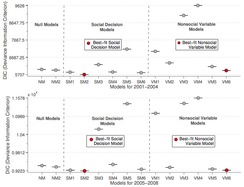Current Research Projects

Emergent Segregation through Homophilic Imitation: The Case of School Choice.
Co-authored with Richard P. Mann, Mats Lillehagen and Gunn E. Birkelund (in major revision)
Segregation by ethnicity, income and other factors still continues in many areas of life. Its prevalence is usually explained by some variation of Schelling's preference-based segregation model. Here we suggest and test a different individual-level mechanism that potentially generates emergent segregation: homophilic imitation. We assume that people tend to mimic choices of those similar to them. We study this mechanism in the context of school choice. To test our hypothesis we use a model of social decision making that describes how individuals estimate the quality of potential choices from the observed actions of others, and how these estimates can be used to predict further actions. Using methods of Bayesian inference, along with individual-level school choices extracted from Norwegian government register data, we establish how homophily influences choice imitation behaviour, particularly in the context of free school choice policy, which then contributes to segregation.
Co-authored with Richard P. Mann, Mats Lillehagen and Gunn E. Birkelund (in major revision)
Segregation by ethnicity, income and other factors still continues in many areas of life. Its prevalence is usually explained by some variation of Schelling's preference-based segregation model. Here we suggest and test a different individual-level mechanism that potentially generates emergent segregation: homophilic imitation. We assume that people tend to mimic choices of those similar to them. We study this mechanism in the context of school choice. To test our hypothesis we use a model of social decision making that describes how individuals estimate the quality of potential choices from the observed actions of others, and how these estimates can be used to predict further actions. Using methods of Bayesian inference, along with individual-level school choices extracted from Norwegian government register data, we establish how homophily influences choice imitation behaviour, particularly in the context of free school choice policy, which then contributes to segregation.

The bdynsys Package for Bayesian Dynamical Systems Modeling in R.
Co-authored with Shyam Ranganathan, Richard P. Mann and David J.T. Sumpter
We are currently working on improving and expanding our R package bdynsys. The package bdynsys for panel/ longitudinal data combines methods to model changes in up to four indicators over times as a function of the indicators themselves and up to three predictors using ordinary differential equations (ODEs) with polynomial terms that allow to model complex and nonlinear effects. A Bayesian model selection approach is implemented. The package provides also visualisation tools to plot phase portraits of the dynamic system, showing the complex co-evolution of two indicators over time with the possibility to highlight trajectories for specified entities (e.g. countries, individuals). Furthermore the visualisation tools allow for making predictions of the trajectories of specified entities with respect to the indicators.The new version of the package will come with a paper that we intend to publish in the Journal of Statistical Software. Feedback and suggestions on the package are appreciated.
Co-authored with Shyam Ranganathan, Richard P. Mann and David J.T. Sumpter
We are currently working on improving and expanding our R package bdynsys. The package bdynsys for panel/ longitudinal data combines methods to model changes in up to four indicators over times as a function of the indicators themselves and up to three predictors using ordinary differential equations (ODEs) with polynomial terms that allow to model complex and nonlinear effects. A Bayesian model selection approach is implemented. The package provides also visualisation tools to plot phase portraits of the dynamic system, showing the complex co-evolution of two indicators over time with the possibility to highlight trajectories for specified entities (e.g. countries, individuals). Furthermore the visualisation tools allow for making predictions of the trajectories of specified entities with respect to the indicators.The new version of the package will come with a paper that we intend to publish in the Journal of Statistical Software. Feedback and suggestions on the package are appreciated.